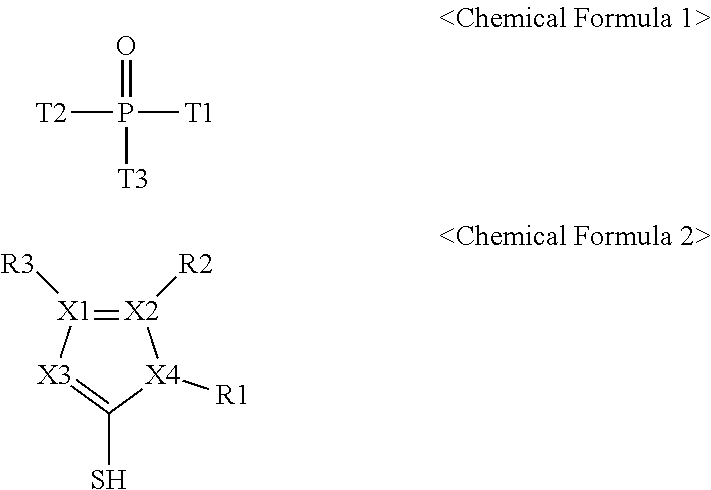Photoresist stripper composition for manufacturing liquid crystal display
a technology of photoresist stripper and composition, which is applied in the direction of photomechanical equipment, detergent compounding agents, instruments, etc., can solve the problems of significant increase in corrosivity of metals including aluminum, corroding metal wires, and producing alien substances, so as to improve the ability to remove, weaken the effect of photoresist stripping ability, and severe decline in corrosion inhibition
- Summary
- Abstract
- Description
- Claims
- Application Information
AI Technical Summary
Benefits of technology
Problems solved by technology
Method used
Image
Examples
example 1
[0062]Evaluation on Amount of Volatilization with Use of Cyclic Alcohol
[0063]A stripper mixed under each evaluation condition was kept on a hot plate at 50° C., a temperature used in the process, and while storing the striper for 48 hours, comparison on the volatized evaporation amount was measured in a weight ratio, and a ratio of changes in the components of an alkanolamine, a major component, and a polar organic solvent was measured under each condition. As materials compared with a cyclic alcohol, materials having the same molecular weight and constituents, and similar boiling points were evaluated, and analysis on the major component was carried out using gas chromatography.
[0064]As Comparative Example 1 and Comparative Example 2 for a cyclic alcohol, linear-structured materials having a similar chemical formula (octanol, decyl alcohol) were selected, and materials having a similar boiling point as well were selected to perform the evaluation.
[0065]Based on the results of the f...
example 2
[0068]Evaluation on Metal Corrosion and Degenerated Photoresist Stripping
[0069]Constituents and content of the photoresist stripper are as listed in the following Table 2. In addition to the components of the following Table 2, ultrapure water was introduced in 35% by weight, a transition metal corrosion inhibiter was introduced in 0.05% by weight, and a potential metal and metal oxide corrosion inhibitor was introduced in 0.225% by weight of each corrosion inhibitor when using two types of potential metal and metal oxide corrosion inhibitors, and in 0.05% by weight when using one type only.
[0070]
TABLE 2PolarGlycolAlkanolCyclicOrganicEtherMetalPotentialTransitionamineAlcoholSolvent29.9%OxideMetalMetal5% by15% by15% bybyCorrosionCorrosionCorrosionweightweightweightweightInhibitorInhibitorInhibitorExample 1MEATHFANMPEDGHPADAPMMIExample 2MIPAFADEFBDGOPAAPMBIExample 3AEETHFADMPAEGDPADAPMBOExample 4AEEOATHFASulfolanePGDDPAAPMBTOExample 5MEATHFANMPEDGHPATMPAMMIExample 6MIPAFADEFBDGOPA—MBI...
example 3
[0086]Evaluation on Metal Corrosion and Degenerated Photoresist Stripping Depending on Changes in the Corrosion Inhibitor Content
PUM
| Property | Measurement | Unit |
|---|---|---|
| temperature | aaaaa | aaaaa |
| weight | aaaaa | aaaaa |
| semiconductor | aaaaa | aaaaa |
Abstract
Description
Claims
Application Information
 Login to View More
Login to View More - R&D
- Intellectual Property
- Life Sciences
- Materials
- Tech Scout
- Unparalleled Data Quality
- Higher Quality Content
- 60% Fewer Hallucinations
Browse by: Latest US Patents, China's latest patents, Technical Efficacy Thesaurus, Application Domain, Technology Topic, Popular Technical Reports.
© 2025 PatSnap. All rights reserved.Legal|Privacy policy|Modern Slavery Act Transparency Statement|Sitemap|About US| Contact US: help@patsnap.com



